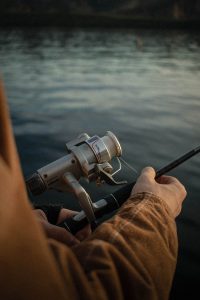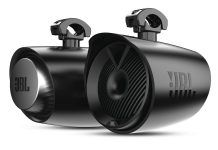Fish Sampling Surveys Conducted At Alamo Lake

AZGFD staff recently went out to Alamo Lake to conduct some sampling for a graduate project with the University of Arizona. Different methodologies of fish sampling were conducted to assess which technique was most favorable with regard to fish density and populations.
Gill nets were set in the mornings and electrofishing was conducted at night. All fish that were caught were released after weight and length were taken. From data collected, Alamo Lake seems to be a relatively healthy system with sample amounts of various species and sizes.
Reminder: Daily Bag Limit For Trout Is Now 4
Anglers are reminded that the daily bag limit for trout this year (includes rainbow, cutthroat, brown, brook, tiger, Gila and Apache trout; grayling) is four. The bag limit was formerly six.
This change was part of the rule amendments approved last year to Commission Order 40. It comes as AZGFD shifts towards stocking larger trout that are preferred in angler-satisfaction surveys. Larger trout take longer to grow and take up more raceway space in a hatchery system that is limited by cold, clean, well-oxygenated water. It is anticipated the average size of the trout will increase to about 13.5 inches.
This change does not affect bag limits on Community Fishing Program or special regulation waters. All anglers are responsible for checking and knowing the current regulations for each water they fish.
Electrofishing Survey Conducted At Tempe Town Lake
AZGFD staff recently conducted an electrofishing survey on Tempe Town Lake. Six sites were shocked to evaluate the largemouth bass population. Several large football-size largemouth bass along with a few large crappie were caught. The largemouth bass population looks very healthy with the largest measuring roughly 20 inches and weighing in at a little over 5 pounds.
Yellow bass, bluegill, redear, green sunfish, tilapia, carp, goldfish, and shad were also caught. Channel and flathead catfish were also surveyed on the lake.
Gila Trout Appear To Be Doing Well In Grapevine Creek
In early spring, Arizona Game and Fish Department and U.S. Fish and Wildlife Service staff completed a population estimate for Gila trout in Grapevine Creek before it opened to catch-and-release angling on May 1.
A total of 107 Gila trout were sampled ranging in length from 3½ to just over 10 inches. Grapevine Creek had no fish prior to the stocking of Gila trout eggs in April of 2019. The oldest fish are just under two years old now and have already grown to more than 10 inches long. This was one of the first stockings of Gila trout eggs in Arizona and the first to result in fish up to 10 inches.
The estimated population size for adults greater than 5 inches in the creek is approximately 243, with an overall population estimate of approximately 336 trout.
The department’s first effort to stock Gila trout in Grapevine in 2009 ran into challenges from Mother Nature and a wildfire that ultimately caused heavy flows of sediment to wash through the creek. Given the history, this is a huge success and the crew was very excited to survey so many fish in the small perennial creek that is only about ¾ miles in length.
Anglers And Boaters: Remember To ‘Clean, Drain And Dry’
To help prevent spread of aquatic invasive species, the Arizona Game and Fish Department (AZGFD) reminds anglers and other boaters to “clean, drain and dry” — and especially decontaminate — their watercraft and equipment before exiting waters designated as having aquatic invasive species (AIS). This is important whether a boater is an Arizona resident or a winter visitor getting ready to trailer a boat back home. AZGFD, along with authorized contractors, is offering free inspections and decontamination of boats traveling away from AIS-designated waters.
“Watercraft inspection and decontamination programs are extremely effective in preventing the spread of AIS, but we need the public’s help,” said Kate Dukette, aquatic invasive species coordinator. “Having your boat inspected and, if necessary, decontaminated is critical in stopping the spread of mussels and AIS into other bodies of water.”
Helping to stop the spread of AIS is the responsibility of everyone working together to protect and keep the state’s waterways clean. In fact, traveling across state lines with AIS can result in fines, quarantines and even impoundments. Decontamination is required for watercraft that have been exposed to quagga mussel-infested waters for six or more consecutive days.
AIS are non-native species that are often unintentionally introduced by human movement. They do not have predators outside of their native range and are able to outcompete native species. They can be animals, plants and even pathogens that cause disease in native fish or other aquatic animals.
Often invisible to the naked eye, AIS can be extremely difficult to control. Once introduced, they can alter or destroy ecosystems by interrupting food chains, cause damage to boats or recreational gear, clog water and power infrastructure, and create safety hazards.
To schedule an inspection or decontamination (call two to three weeks in advance):
- Arizona Game and Fish AIS Program: (623) 236-7608
- Woods to Water Wildlife Solutions LLC: (602) 920-4891
- Katherine Landing (Lake Mohave/Bullhead City): (928) 754-3245
Always remember to take the following steps:
- Clean boats, waders, anchors, equipment and gear by removing mud, plants, and attached animals such as snails or quagga mussels. Freeze waders overnight to eliminate fish pathogens and other aquatic hitchhikers.
- Drain all residual water from engines and motors, ballast tanks, live wells and bait wells. Pull the bilge plug and leave it out during transport. Store it in a location where it will be remembered before the next launch, such as beside the boat keys or in the glove box.
- Dry all equipment that comes in contact with water, such as life jackets, ropes, buoys, tubes, etc.
“It is our responsibility to be stewards of the places that we love,” Dukette said. “Stopping the spread of AIS keeps our waters clean and beautiful for ourselves and future generations.”
For more information on aquatic invasive species, visit: www.azgfd.gov/AIS.
Angler Posts
For each edition of the Fishing Report, we’ll select some photos and reports submitted by members of the angling public either through the Fish AZ Facebook Group or through the bfishing@azgfd.gov email address. If you’d like your photo/report considered for publication here, please indicate the species, place, date, name (we only publish first name and last initial), and any other information you’d like to provide. For more photos (including new photos each day), visit the Fish AZ Facebook Group.
Thank You, Anglers!
Arizona fishing opportunities wouldn’t be possible without the Sport Fish Restoration Program. It was created through the Dingell-Johnson Act of 1950 (Federal Aid in Sport Fish Restoration Act) and the Wallop-Breaux amendments of 1984. Through a federal excise tax paid by manufacturers on fishing gear and motorboat fuels, it provides grant funds for fishery conservation, boating access, and aquatic education.































